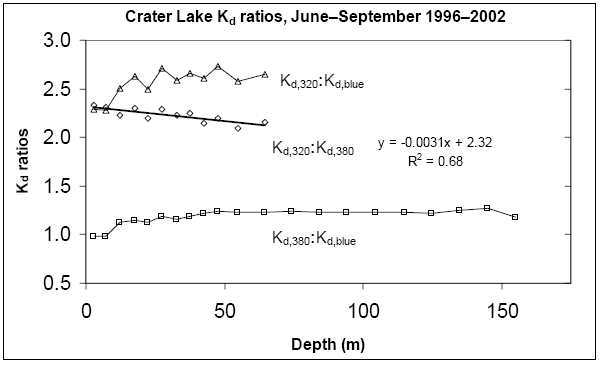To our knowledge particulate organic carbon (POC) has not been used as a proxy for Kd,UV. In Crater Lake we observed that UV attenuation can be characterized by a combination of cp660 and Fchl, the former more important near the surface and the latter more important at greater depths (Figure 11A). This relationship seems reasonable in an oligotrophic lake with low levels of DOC because the cp660 detects scattering by cells when absorption by chlorophyll-a is suppressed at high light levels in the process of photoacclimation. The cells at shallower depths will still be attenuating UV wavelengths because of their inevitable content of other UV-absorbing molecules. Figure 11B clearly shows the consequence of photoacclimation in the phytoplankton community as the chlorophyll-a concentration per unit of carbon (and presumably per cell) is reduced at depths shallower than 50–75 m. Below this range of depths the chlorophyll-a concentration and the effective light absorbing properties of chlorophyll-a are increased as phytoplankton adapt to low light conditions. Along with the chlorophyll-a there are accessory pigments and macromolecules that absorb UVR. It is not clear how the pattern in Figure 11B is modified by exposure to the high levels of UVR because one can imagine something similar would result simply from exposure to visible wavelengths. And where ever the microbial community develops in the water column, one can expect to find detrital particles and dissolved DOC co-varying with the living cells.
While depth profiles of cp660 typically show the pattern for biomass distribution in Crater Lake suggesting a biomass peak ranging from 50–100 m (Boss et al., this issue) the cp660 signal also detects scattering caused by suspended mineral particles entering with runoff from heavy rain. The seasonal and depth patterns of cp660 for 1995, a year with unusually high optical attenuation and heavy summer rain, demonstrate the slow transport of sediments from the surface to the bottom. Depth profiles for 1995 (Figure 9A) showed an unusual cp660 peak in turbidity close to the surface during July and August and peaks deeper in the water column (>250 m) that were not present in other years. A time course for the near-surface and near-bottom cp660 signal in Figure 9B compares 1994, a more typical dry year, with 1995. During June and July of 1995 the Crater Lake weather records included several precipitation events and an unusually late time (5 July) for melting of the snow pack at the Park Headquarters weather station and one of the authors (MWB) recorded observations of downslope sediment transport into the water and turbidity in the lake surface in response to these storms. Water column peaks in the cp660 signal could be caused by mineral particles or phytoplankton. Records of [chlorophyll-a] averaged over 0–30 m do not show elevated values for July 1995 compared to other years (Figure 15A). Turbidity traveling down the water column has appeared in transmissometer records from other years (e.g. 1991, 1996, 1997, 1998) but the entry of turbidity from runoff down the slopes and into the surface waters, followed by spreading across the lake by wind driven currents has only been reported for 1995.
Figure 6. Crater Lake Kd ratios from data in Figure 5 (June–September 1996–2002, LI-1800uw). Least squares regression for Kd,320:Kd,380 versus depth (m), y = -0.0031x + 2.32, r2=0.68. Average 0–10 m ratios: Kd,320:Kd,blue, 2.28 (SE=0.007), Kd,380:Kd,blue, 0.98 (SE=0.002), Kd,320:Kd,380 = 2.32 (SE = 0.012). Average 0–40 m ratios: Kd,320:Kd,blue = 2.52 (SE=0.058); Kd,380:Kd,blue = 1.11 (SE=0.029); Kd,320:Kd,380 = 2.27 (SE = 0.016).


